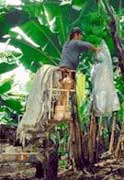|
Intercultural Operations
Weed control
During early stages, complete control of weeds could be obtained by raising cowpea
in the interspaces. In gardens where this is not possible, pre-emergence application
of diuron 1.5 kg/ha or oxyfluorfen 0.2 kg/ha is effective. Weeds emerging later
could be controlled by the application of glyphosate 0.4 kg/ha. If hand weeding
is resorted to, give 4-5 surface diggings depending on weed growth. Avoid deep digging.
Do not disturb soil after plants start producing bunches. If green manure crop is
grown, weeding operations can be reduced to 1-2 diggings.
Desuckering
Remove side suckers produced till the emergence of bunch. Retain one or two suckers
produced after the emergence of bunch.
Intercropping in Nendran variety
Cucumber and amaranth can be cultivated profitably with banana raised in September-October
without affecting the bunch weight. For vegetable purpose, cucumber may be harvested
within 95 days and for seed purpose the duration may be about 130 days. Greater
yam and elephant foot yam can be profitably intercropped with Nendran.
Removal of male bud
The part of the inflorescence which consists of male flowers only, is invariably
termed in different parts of the world as male bud, heart, or navel. This has apparently
no comprehensible function or value in the normal bunch formation or development.
It was found that pruning the male bud had resulted in some increase in both the
length and circumference of the fruit (http://www.ikisan.com/)
In respect of mean duration from shooting to maturity, there was reduction of light
days in the pruned plants.
In the case of yield also, there was a significant increase of 0.9 kg in the mean
bunch weight of pruned plants which worked out to 7.5 per cent increase in yield.
Other advantages in pruning the male bud include extra monetary returns by sale
of male buds which are used as vegetable.
It was observed that the banana thrips which attack the fruit and cause unsightly
brown freckling on the fruit, live and breed in the male buds in large numbers.
The removal of the male buds obviously results in less damage from this pest.
Propping of banana plants
One of the important problems facing banana growers is the lodging of plants with
mature or immature bunches during heavy winds and cyclones. The plants are uprooted
or broken at the middle resulting in heavy losses to the growers.
To overcome this problem, the plants have to be propped with bamboos or caesarian
poles. Single props are given. The top of the prop is placed against the throat
of the plant, under the curvature of the bunch stem.
Trimming of leaves and care of banana bunches
Leaf trimming is an important operation for controlling certain leaf diseases and
for promoting light penetration.
Trimming is the removal of the dead leaves that hang down the sides of the pseudostem.
It is very important that only the dead and diseased leaves are cut and removed
and not the still green leaves that often hang down the side of the pseudostem.
By removing those green leaves, the photosynthetic area is reduced and the final
bunch size is affected.
Leaf removal may be done throughout the growing season. By keeping the plantation
clean, more light and heat are available for promoting plant growth.
Further advantages of removing dead and dried leaves are that the potential dangers
of fruit injury and disease infection are reduced.
Bunch covering

|
Bagging is a cultural technique used by planters in the French West Indies, Latin
America, Africa, Australia, etc., particularly, where export bananas are grown.
The main purposes are the protection of bunches against cold,
sun scorching, attack of thrips and scarring beetle.
It also improves certain visual qualities of the fruits. Bunch covering with dry
leaves is a common practice in India, which, however, may be a source of inoculum
for post-harvest diseases.
|
Earthing up
Earthing up should be done during the rainy season to provide drainage, and to avoid
waterlogging at the base. During summer and winter, the plants should be in furrow
and on ridges during rainy season.
Top
|